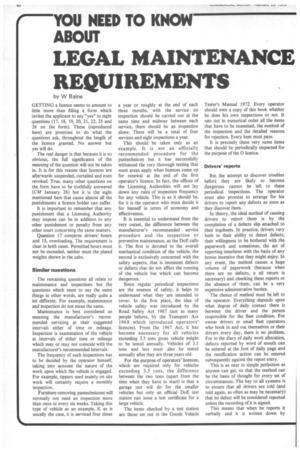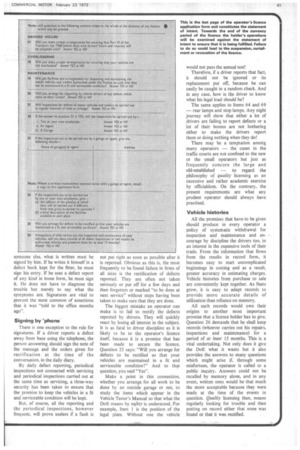( ---- YOU NEED TO KNOW
Page 40

Page 41

If you've noticed an error in this article please click here to report it so we can fix it.
ABOUT
LEGAL MAINTENANCE REQUIREMENTS
by W Balne GETTING a licence seems to amount to little more than filling a form which invites the applicant to say "yes" to eight questions (17, 18, 19, 20, 21, 22, 25 and 26 on the form). These (reproduced here) are promises to do what the questions ask, throughout the length of the licence granted. No answer but yes will do.
The real danger is that because it is so obvious, the full significance of the meaning of the question will not be taken in. It is for this reason that licences are afterwards suspended, curtailed and even revoked. True, many other questions on the form have to be truthfully answered (C/lif January 26) but it is the eight mentioned here that cause almost all the punishments a licence holder can suffer.
It is important to remember that any punishment that a Licensing Authority may impose can be in addition to any other punishment or penalty from any other court concerning the same matters.
Question 17 concerns drivers' hours and 18, overloading. The requirement is clear in both cases. Permitted hours must not be exceeded, neither must the plated weights shown in the cabs.
Similar auestions
The remaining questions all relate to maintenance and inspections but the questions which seem to say the same things in other words, are really quite a lot different. For example, maintenance and inspection do not mean the same.
Maintenance is best considered as meaning the manufacturer's recommended servicing at their suggested intervals either of time or mileage. Inspection is examination of the vehicle at intervals of either time or mileage which may or may not coincide with the manufacturer's recommended intervals.
The frequency of such inspections has to be decided by the operator himself, taking into account the nature of the work upon which the vehicle is engaged. For example, tippers used mainly on site work will certainly require a monthly inspection.
Furniture-removing pantechnicons will normally not need an inspection more than once in every six weeks. Taking this type of vehicle as an example, if, as is usually the case, it is serviced four times a year or roughly at the end of each three months, with the service an inspection should be carried out at the same time and midway between each service, there should be an inspection alone. There will be a total of four services and eight inspections a year.
This should be taken only as an example. It is not an officially recommended procedure for the pantechnicon but it has successfully withstood the very thorough testing that most areas apply when licences come up for renewal at the end of the first operator's licence. In fact, the offices of the Licensing Authorities will not lay down any rules of inspection frequency for any vehicle. This is as it should be, for it is the operator who must decide it for himself in terms of economy and effectiveness.
It is essential to understand from the very outset, the difference between the manufacturer's recommended service procedure and the inspection or preventive maintenance, as the DoE calls it. The first is devoted to the overall mechanical condition of the vehicle, the second is exclusively concerned with the safety aspects, that is imminent defects or defects that do not affect the running of the vehicle but which can become dangerous.
Since regular periodical inspections are the essence of safety, it helps to understand what they are intended to cover. In the first place, the idea of vehicle safety was introduced by the Road Safety Act 1967 (not as many people believe, by the Transport Act 1968 which introduced operators' licences). From the 1967 Act, it has become necessary for all vehicles exceeding 3.5 tons gross vehicle weight to be tested annually. Vehicles of 3.5 tons and less must also be tested annually after they are three years old.
For the purpose of operators' licences, which are required only for vehicles exceeding 3.5 tons, the difference between the two tests (apart from the time when they have to start) is that a garage test will do for the smaller vehicles but only an official DoE test station can issue a test certificate for a large vehicle.
The items checked by a test station are those set out in the Goods Vehicle Tester's Manual 1972. Every operator should own a copy of this book whether he does his own inspections or not. It sets out in numerical order all the items that have to be examined, the method of the inspection and the detailed reasons for rejection. Every item must pass.
It is precisely these very same items that should be periodically inspected for the purpose of the 0 licence.
Drivers' reports
But the attempt to discover troubles before they are likely to become dangerous cannot be left to these periodical inspections. The operator must also promise to arrange for his drivers to report any defects as soon as they discover them.
In theory, the ideal method of causing drivers to report them is by the completion of a defects slip attached to their logsheets. In practice, drivers vary both in their ability to detect defects, their willingness to be bothered with the paperwork and sometimes, the act of reporting interferes with the basis of any bonus incentive that they might.enjoy. In any event, the method causes a huge volume of paperwork (because when there are no defects, a nil return is necessary) and checking these reports or the absence of them, can be a very expensive administrative burden.
The choice of method must be left to the operator. Everything depends upon what degree of daily contact there is between the driver and the person responsible for the fleet condition. For owner drivers or small fleet operators who book in and out themselves or their drivers every day, there is no problem. For in the diary of daily work allocation, defects reported by word of mouth can be entered at the foot of daily page and the rectification action can be entered subsequently against the report entry.
This is as near to simple perfection as anyone can get, so that the method can be the basis of thought for every set of circumstances. The key to all systems is to ensure that all drivers are told (and told again, as often as may be necessary) that no defect will be considered reported unless the recording of it is signed.
This means that when he reports it verbally and it is written down by someone else, what is written must be signed by him. If he writes it himself in a defect book kept for the fitter, he must sign his entry. If he uses a defect report of any kind in loose form, he must sign it. He does not have to diagnose the trouble but merely to say what the symptoms are. Signatures are vital to prevent the most common of assertions that it was "told to the office months ago".
Signing by 'phone There is one exception to the rule for signatures. If a driver reports a defect away from base using the telephone, the person answering should sign the note of the message and the orders given for rectification at the time of the conversation, in the daily diary.
By daily defect reporting, periodical inspections not connected with servicing and periodical inspections carried out at the same time as servicing, a three-way security has been taken to ensure that the promise to keep the vehicles in a fit and serviceable condition will be kept.
But, of course, all the reporting and the periodical inspections, however frequent, will prove useless if a fault is not put right as soon as possible after it is reported. Obvious as this is. the most frequently to be found failure in firms of all sizes is the rectification of defects reported. They are often not taken seriously or put off for a few days and then forgotten or marked "to be done at next service" without steps having been taken to make sure that they are done.
The biggest mistake an operator can make is to fail to rectify the defects reported by drivers. They will quickly react by losing all interest in the subject. It is as fatal to driver discipline as it is likely to be to the operator's licence itself, because it is a promise that has been made to secure the licence. Question 25 says: "Will you arrange for defects to be rectified so that your vehicles are maintained in a fit and serviceable condition?" And to that question, you said "Yes".
Make a point in this connection, whether you arrange for all work to be done by an outside garage or not, to study the items which appear in the Vehicle Tester's Manual so that what the DoE means by safety is understood. For example, Item I is the position of the legal plate. Without one the vehicle
would not pass the annual test!
Therefore, if a driver reports that fact, it should not be ignored or its replacement put off, because he can easily be caught in a random check. And in any case, how is the driver to know what his legal load should be?
The same applies to Items 64 and 69 — rear lamps and stop lamps. Any night journey will show that either a lot of drivers are failing to report defects or a lot of their bosses are not bothering either to make the drivers report them or doing nothing when they do!
There may be a temptation among many operators — the cases in the traffic courts are not confined to the new or the small operators but just as frequently concern the large and old-established — to regard the philosophy of quality licensing as an excessive and rather academic exercise by officialdom. On the contrary, the present requirements are what any prudent operator should always have practised.
Vehicle histories All the promises that have to be given should produce in every operator a policy of systematic withdrawal for inspection and maintenance and encourage by discipline the drivers too, in an interest in the expensive tools of their trade. From the information that flows from the results in record form, it becomes easy to start uncomplicated beginnings in costing and as a result, greater accuracy in estimating charges. Vehicle histories from purchase to sale are conveniently kept together. As fleets grow, it is easy to adapt records to provide more accurate details of utilization than reliance on memory.
All such records would owe their origins to another most important promise that a licence holder has to give. Question 26 demands that he shall keep records (whoever carries out his repairs, inspections and maintenance) for a period of at least 15 months. This is a vital undertaking. Not only does it give the DoE what it wants but it also provides the answers to many questions which might arise if, through some misfortune, the operator is called to a public inquiry. Answers could not be recalled by memory alone, and in any event, written ones would be that much the more acceptable because they were made at the time of the events in question. Quality licensing then, means regularly looking for trouble and then putting on record either that none was found or that it was rectified.
































































































